3.3: Exponential Functions
Learning Objectives
- Evaluate exponential functions.
- List the properties of exponential functions and their graphs.
- Solve exponential equations.
Evaluating Exponential Functions
For any real number [latex]x[/latex], an exponential function is a function with the form
[latex]f\left(x\right)=ab^x[/latex]
where
- [latex]a[/latex] is a non-zero real number called the initial value and
- [latex]b[/latex] is any positive real number such that [latex]b\neq1[/latex].
- The domain of [latex]f[/latex] is all real numbers.
- The range of [latex]f[/latex] is all positive real numbers if [latex]a>0[/latex].
- The range of [latex]f[/latex] is all negative real numbers if [latex]a<0[/latex].
- The y-intercept is [latex]\left(0,\;a\right)[/latex], and the horizontal asymptote is [latex]y=0[/latex].

It is important to correctly identify the base of an exponential function. In the standard form [latex]f\left(x\right)=ab^x[/latex], the variable [latex]x[/latex] is the exponent, [latex]b[/latex] represents the base, and [latex]a[/latex] is a constant coefficient. Please refer to the attached image for clarification.
| [latex]{\color[rgb]{1.0, 1.0, 1.0}\boldsymbol f}\mathbf{\color[rgb]{1.0, 1.0, 1.0}\left(x\right)}{\color[rgb]{1.0, 1.0, 1.0}\mathbf=}{\color[rgb]{1.0, 1.0, 1.0}\boldsymbol a}{\color[rgb]{1.0, 1.0, 1.0}\boldsymbol b}^{\color[rgb]{1.0, 1.0, 1.0}\mathbf x}[/latex] | |
|---|---|
| [latex]a[/latex] | Coefficient |
| [latex]b[/latex] | Base |
| [latex]x[/latex] | Power/exponent |
Example 3.3-1-1: Identifying Exponential Functions: Identify the base of the exponential function. And find the value for part c and d
- [latex]f\left(x\right)=4^{3\left(x-2\right)}[/latex]
- [latex]f\left(x\right)=0.35e^{3+x}[/latex]
- [latex]f\left(x\right)=-\frac13^2[/latex]
- [latex]f\left(x\right)=\left(-\frac13\right)^2[/latex]
 Key
Key
Example 3.3-1-1: Identifying Exponential Functions: Identify the base of the exponential function. And find the value for part c and d
- [latex]f\left(x\right)=4^{3\left(x-2\right)}[/latex]
- [latex]f\left(x\right)=0.35e^{3+x}[/latex]
- [latex]f\left(x\right)=-\frac13^2[/latex]
- [latex]f\left(x\right)=\left(-\frac13\right)^2[/latex]
- [latex]f\left(x\right)=4^{3\left(x-2\right)}[/latex] the base is [latex]4[/latex].
- [latex]f\left(x\right)=0.35e^{3+x}[/latex] the base is [latex]e[/latex].
- [latex]f\left(x\right)=-\frac13^2[/latex] the base is [latex]\frac13[/latex].
[latex]f\left(x\right)=-\cdot\frac13\cdot\frac13=-\frac19[/latex]
- [latex]f\left(x\right)=\left(-\frac13\right)^2[/latex] the base is [latex]-\frac13[/latex].
[latex]f\left(x\right)=\left(-\frac13\right)\left(-\frac13\right)=\frac19[/latex]
Your Turn
Practice 3.3-1-1
Properties of Exponential Functions
[latex]f\left(x\right)=a^x\;or\;y=a^x,\;where\;a>0,\;a\neq1,\;and\;x\in\mathbb{R}\;\left(Domain\right),\;f\left(x\right)>0\left(range\right).[/latex] The shape of the graph of [latex]f\left(x\right)=a^x[/latex] is given by:
- If [latex]0<[/latex] [latex]a<1[/latex], then the function decreases from left to right.
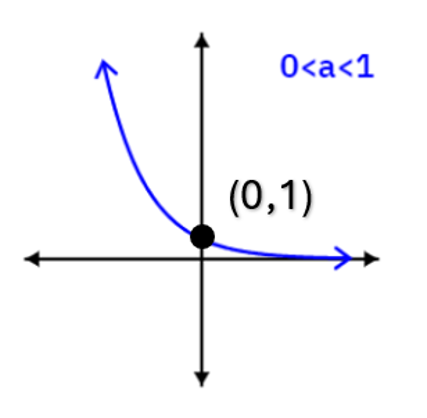
- If [latex]a>1[/latex], then the function increases from left to right.
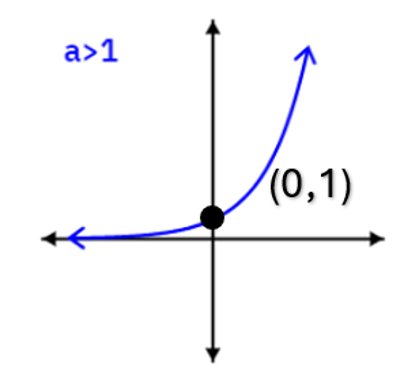
- Both always pass [latex](0,1)[/latex].
- A graph of exponential function [latex]f\left(x\right)=a^x[/latex] or [latex]y=a^x[/latex], where [latex]a>0,\;a\neq1[/latex], has no x-intercept.
Example 3.3-2-1: Graph the function.
[latex]f\left(x\right)=8^x[/latex]
 Key
Key
Example 3.3-2-1: Graph the function.
[latex]f\left(x\right)=8^x[/latex]
Based on the property, we know that x can be any value; thus, we can use a table to graph the function.
| [latex]{\color[rgb]{1.0, 1.0, 1.0}\boldsymbol x}[/latex] | [latex]{\color[rgb]{1.0, 1.0, 1.0}\boldsymbol f}\mathbf{\color[rgb]{1.0, 1.0, 1.0}\left(x\right)}[/latex] | [latex]\mathbf{\color[rgb]{1.0, 1.0, 1.0}\left({x,\;y}\right)}[/latex] |
|---|---|---|
| -1 | [latex]8^{-1}=\frac18=0.125[/latex] | [latex]\left(-1,\;0.125\right)[/latex] |
| 0 | [latex]8^0=1[/latex] | [latex]\left(0,\;1\right)[/latex] |
| 1 | [latex]8^1=8[/latex] | [latex]\left(1,\;8\right)[/latex] |
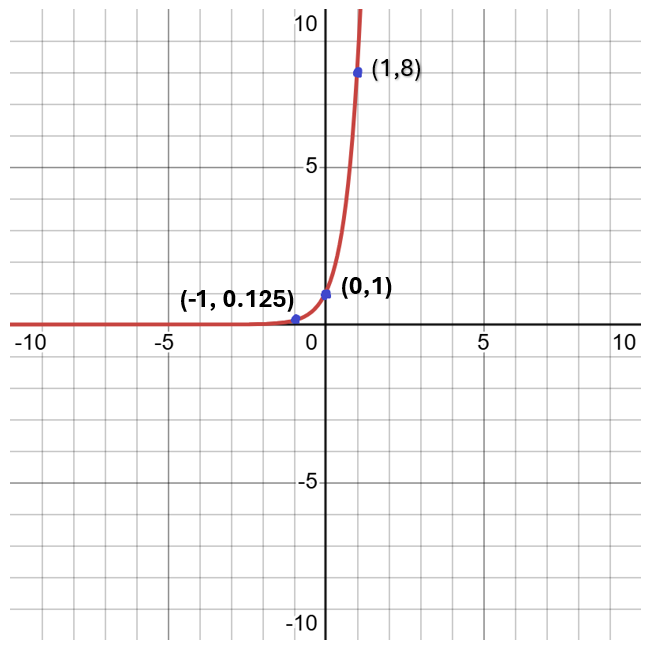

Tips for graphing problem works for ALL:
- Identify the Domain – Determine which x-values are valid for the function.
- Choose x-Values – Select a few values within the domain.
- Calculate y-Values – Plug x-values into the function to find corresponding y-values.
- Plot Points – Write each (x, y) as coordinates and plot them.
- Draw and Extend – Connect the points smoothly and extend the graph based on function properties.
 Your Turn
Your Turn
Practice 3.3-2-1
Evaluate composite functions
Using the One-to-One Property to Solve Exponential Equations
[latex]If\;a^u=a^v,\;then\;u=v.[/latex]
- Rewrite the equation in the form [latex]a^u=a^v[/latex].
- Set [latex]u=v[/latex].
- Solve for the variable.
 |
Tips: To solve exponential equations effectively, ensure that both sides have the same base and that the coefficient of the exponential term is 1. If the bases differ, attempt to express both sides using a common base, often starting with prime numbers such as 2, 3, 5, or 7. |
Useful Rules:
| [latex]b=b^1[/latex] | ([latex]b[/latex] is any number) when power is [latex]1[/latex], we do not write it out. |
|---|---|
| [latex]b^0=1[/latex] | any number with power [latex]0[/latex] is [latex]1[/latex]. |
| [latex]b^m\cdot b^n=b^{m+n}[/latex] | multiply powers of the same base, add exponents. |
| [latex]\frac{b^m}{b^n}=b^{m-n}[/latex] | divide powers of the same base, subtract (numerator exponent minus denominator exponent). |
| [latex]\left(b^m\right)^n=b^{m\cdot n}[/latex] | multiple powers, multiple powers. |
| [latex]b^{-n}=\frac1{b^n}\;and\;\frac1{b^{-n}}=b^n[/latex] | negative powers, reciprocal base, change power to positive. |
| [latex]\left(a\cdot b\right)^n=a^n\cdot b^n[/latex] | raise a product to a power, raise power for each base. |
| [latex]\left(\frac ab\right)^n=\frac{a^n}{b^n}[/latex] | raise fraction to a power, raise power for numerator and denominator. |
| [latex]\left(\frac ab\right)^{-n}=\left(\frac ba\right)^n[/latex] | fraction raised to a negative power, reciprocal fraction change power to positive. |
Example 3.3-3-1: Solve Elementary Exponential Equations.
[latex]3^{x+1}=81[/latex]
 Key
Key
Example 3.3-3-1: Solve Elementary Exponential Equations.
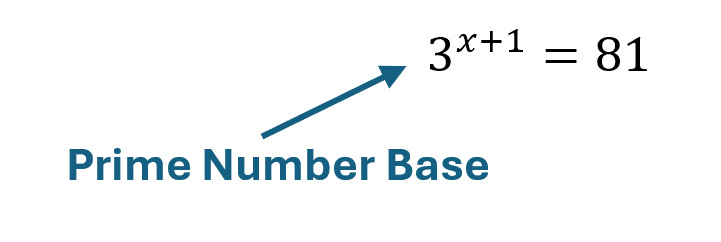
Step 1: To have [latex]a^u=a^v[/latex] we need to rewriting [latex]81[/latex] with Base [latex]3[/latex], We choose base [latex]3[/latex] because the expression on the right side involves base [latex]3[/latex]. Additionally, [latex]3[/latex] is a prime number, meaning it cannot be reduced to any other integer base.
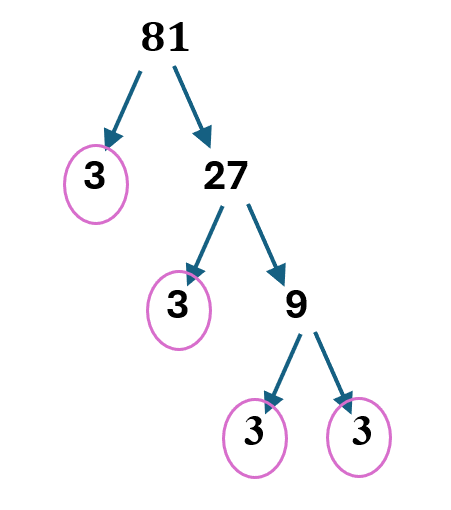
[latex]81={\color[rgb]{0.5, 0.0, 0.5}\mathbf3}^{\color[rgb]{0.5, 0.0, 0.5}\mathbf4}[/latex]
Thus:
[latex]3^{x+1}=81[/latex]
[latex]3^{x+1}={\color[rgb]{0.5, 0.0, 0.5}\mathbf3}^{\color[rgb]{0.5, 0.0, 0.5}\mathbf4}[/latex]
Step 2: Since left and right bases are the same, we just need to compare the power.
[latex]x+1=4[/latex]
Step 3: Solve for the variable.
[latex]x=4-1[/latex]
[latex]x=3[/latex]
Example 3.3-3-2: Solve Elementary Exponential Equations.
[latex]7^{x+3}=\frac17[/latex]
 Key
Key
Example 3.3-3-2: Solve Elementary Exponential Equations.

Step 1: To have [latex]a^u=a^v[/latex] we need to flip [latex]\frac17[/latex]
Based on the rule
[latex]\left(\frac ab\right)^{-n}=\left(\frac ba\right)^n[/latex]
[latex]\frac17=\left(\frac17\right)^1=\left(\frac17\right)^{-1}=7^{-1}[/latex]
Thus:
[latex]\frac17=7^{-1}[/latex]
[latex]7^{x+3}={\color[rgb]{0.5, 0.0, 0.5}\frac{\mathbf1}{\mathbf7}}[/latex]
[latex]7^{x+3}={\color[rgb]{0.5, 0.0, 0.5}\mathbf7}^{\color[rgb]{0.5, 0.0, 0.5}{\boldsymbol-\mathbf1}}[/latex]
Step 2: Since left and right bases are the same, we just need to compare the power.
[latex]x+3=-1[/latex]
Step 3: Solve for the variable.
[latex]x=-1-3[/latex]
[latex]x=-4[/latex]
Example 3.3-3-3: Solve Elementary Exponential Equations.
[latex]8^{x+2}=4^{x-3}[/latex]
 Key
Key
Example 3.3-3-3: Solve Elementary Exponential Equations.

Step 1: To have [latex]a^u=a^v[/latex] we can first reduce both bases to prime numbers.
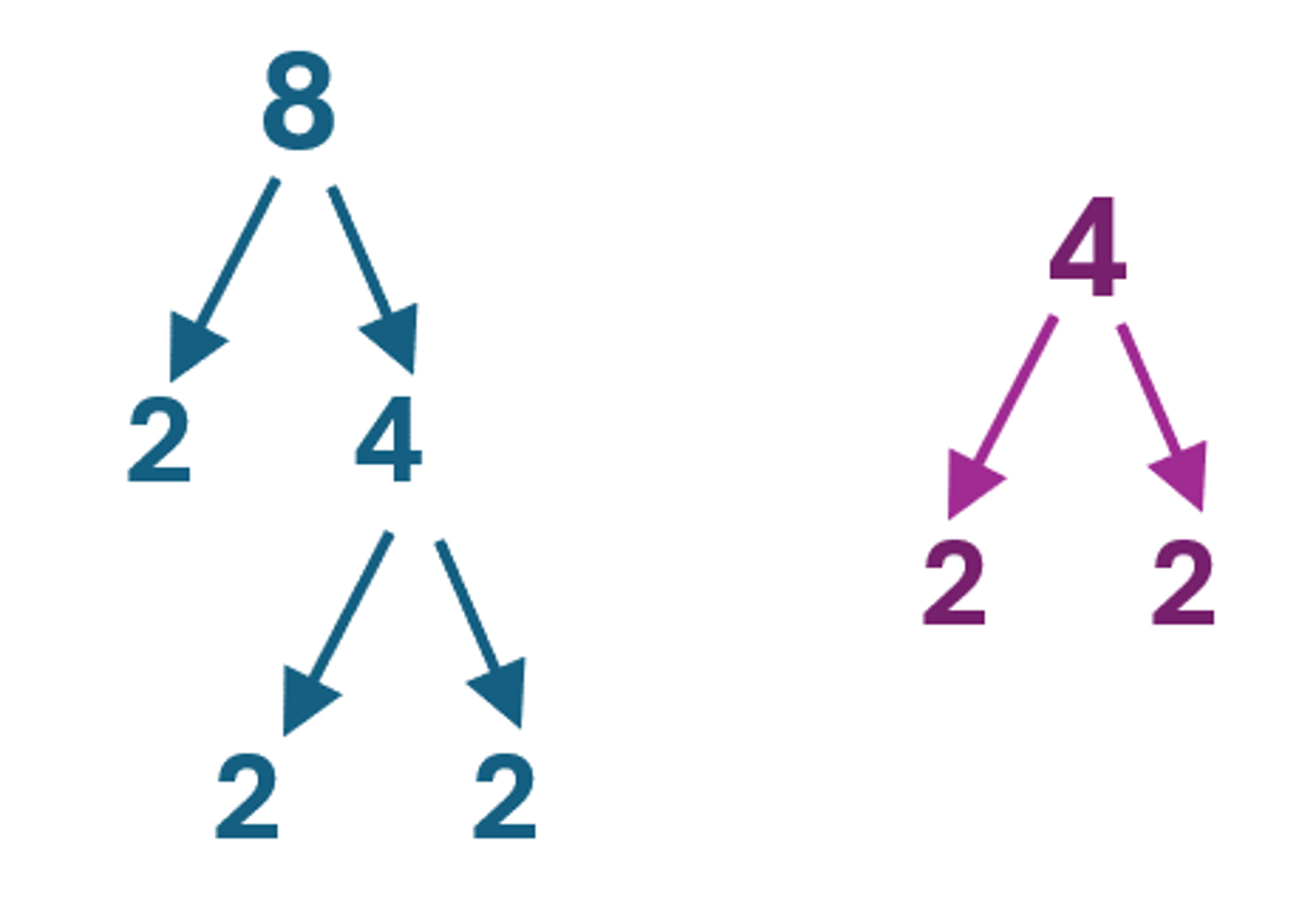
Thus: [latex]8=2^3,\;4=2^2[/latex]
[latex]\left({\color[rgb]{0.0, 0.44, 0.73}\mathbf2}^{\color[rgb]{0.0, 0.44, 0.73}\mathbf3}\right)^{x+2}=\left({\color[rgb]{0.5, 0.0, 0.5}\mathbf2}^{\color[rgb]{0.5, 0.0, 0.5}\mathbf2}\right)^{x-3}[/latex]
Simplify the equation by using rule
[latex]\left(b^m\right)^n=b^{m\cdot n}[/latex]
[latex]{\color[rgb]{0.0, 0.44, 0.73}\mathbf2}^{\left({\color[rgb]{0.0, 0.44, 0.73}\mathbf3}\right)\left(x+2\right)}={\color[rgb]{0.5, 0.0, 0.5}\mathbf2}^{\left({\color[rgb]{0.5, 0.0, 0.5}\mathbf2}\right)\left(x-3\right)}[/latex]
[latex]{\color[rgb]{0.0, 0.44, 0.73}\mathbf2}^{{\color[rgb]{0.0, 0.44, 0.73}\mathbf3}x+6}={\color[rgb]{0.5, 0.0, 0.5}\mathbf2}^{{\color[rgb]{0.5, 0.0, 0.5}\mathbf2}x-6}[/latex]
Step 2: Since left and right bases are the same, we just need to compare the power.
[latex]3x+6=2x-6[/latex]
Step 3: Solve for the variable.
[latex]3x-2x+6=-6[/latex]
[latex]x+6=-6[/latex]
[latex]x=-6-6[/latex]
[latex]x=-12[/latex]
 Your Turn
Your Turn
Practice 3.3-3-1
Licenses and Attribution
CC Licensed Content
- College-algebra-2e by Jay Abramson is licensed CC BY. Access for free.

